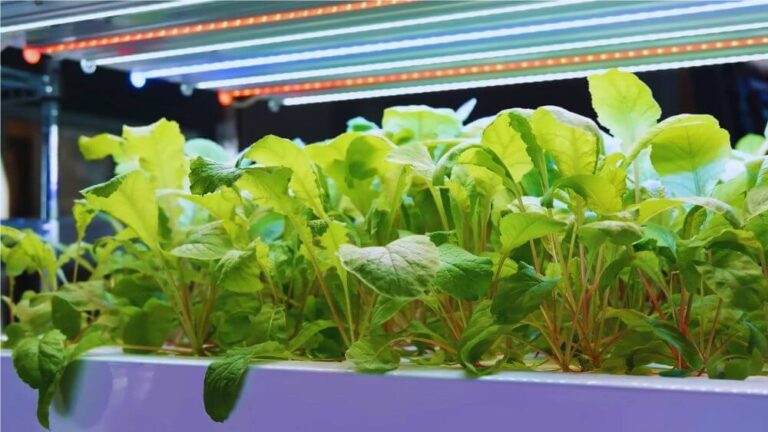Kratky Method Hydroponics: DIY Guide and Top Tips
Kratky hydroponics, a soil-free gardening method, is easy and efficient. It’s suitable for beginners and DIYers because it requires minimal equipment and maintenance.
Dr. B.A. Kratky developed this method, which requires no electricity or complicated equipment. It’s cost-effective and eco-friendly. Imagine growing herbs, veggies, or flowers without daily watering or expensive equipment. That’s the beauty of the Kratky method!
This hydroponic system isn’t just easy; it’s also efficient. It’s like setting up a self-sustaining plant ecosystem in your home. Whether you live in an apartment with a tiny balcony or a house with a spacious sunroom, the Kratky method fits right in. It’s all about growing more with less—less water, space, and hassle!
The Kratky Method Hydroponics: Details
What is the Kratky Method?
In a word, it’s a passive hydroponic system. No fancy pumps or electricity is required. This Kratky technique works by suspending the roots in a nutrient solution that decreases as the plant grows and consumes it. As a result, it creates an air gap for the roots to breathe in.
Kratky Hydroponics: Perfect for Beginners
There are many reasons why beginners love Kratky Method Hydroponics. First, it’s low-maintenance. No daily watering, no soil worries, no back-breaking weeding. Gardening is easy. And it’s budget-friendly, too!
Kratky vs. Other Hydroponic Systems
Kratky hydroponics is a simple and cheap system compared to other systems that require many resources. Different systems require constant circulation of nutrient solutions and aeration to prevent root rot and oxygen depletion.
Kratky is suitable for small-scale and newbies who want to try hydroponics with minimal investment and maintenance.
However, it has limitations, such as being unable to support large or long-term plants, being prone to evaporation and algae growth, and having less efficient nutrient uptake than other hydroponic systems.
Kratky Method Setup (DIY).
Building Your Kratky System
Want to get dirty (not literally, since there’s no dirt involved)? It’s easier to set up your system than to bake a pie. Here’s how:
Gather Your Stuff: First, gather a container, bucket, or large jar. Then, make sure you have a lid or cover. Net pots and hydroponic nutrients. And don’t forget your seedlings or seeds in the mix!
Container Prep: Drill holes in the lid of your container for the net pots. Plants should fit in snugly.
Nutrient Solution to the Rescue: Add water and hydroponic nutrients to the container. This feeds your plants.
Plant Time: Put your plants or seeds in the net pots; if you use seedlings, ensure the roots touch the nutrient solution.
Location: Find a sunny spot for your Kratky. A window ledge or balcony that gets lots of light is perfect.
Kratky Tips
Right Container: Dark containers prevent algae growth. You can block the light by wrapping a clear container in foil.
Water Levels: Check water levels often. You’ll need to top it off sometimes since your plants will drink it all up.
Happy Plants: Look for green leaves and strong stems.
Kratky-Friendly Plants: A Selection Guide
Alright, now that you’re all set up, it’s time to pick your green buddies! The Kratky system does not treat all plants equally. So, let’s find out which plants will make your garden a success.
The Perfect Kratky Plants
Leafy Greens Galore: Lettuce, spinach, and kale thrive in Kratky hydroponics; they also grow quickly and require minimal space.
Herb Haven: Basil, cilantro, and parsley thrive in this system. From your window, you can have fresh herbs for cooking!
Small and Mighty: Compact plants like strawberries and cherry tomatoes are also very suitable choices.
Planting Tips for Success
Spacing is Key: Give your plants enough room to grow. Additionally, a lack of air circulation can lead to poor growth in overcrowded environments.
Starting Right: You can start with seeds or seedlings. If using seedlings, gently wash off the soil before transferring them to net pots.
Kratky Systems: Nutrients and Water Management
It is where the magic happens! Your plants need the right mix of nutrients and water to flourish. Let’s break it down.
Mixing the Perfect Nutrient Solution
Follow the Instructions: Each nutrient pack comes with instructions. Stick to them for the most effective results.
pH Balance: Aim for a pH between 5.5 and 6.5. You can get a testing kit to keep it in check.
Water Level Wonders
Start High, Go Low: Initially, the water level should be high enough to touch the plant roots. As plants grow, lower the water level to encourage air space development.
Keeping Your Garden Flourishing
Regular Checks: Monitor your nutrient solution weekly. Top off with water as needed, but remember, the nutrient concentration should not dilute too much.

Kratky Methods: Common Challenges and Solutions
Even the most experienced growers face challenges but don’t worry. Here’s how to fix common problems:
Pests and Diseases: Prevention is the best; keep it clean. If pests show up, use neem oil.
Nutrient Deficiencies: Watch for yellowing leaves or stunted growth, which means nutrient issues. Adjust your nutrient solution as needed.
Algae Growth: Keep it dark; cover any exposed nutrient solution; and use opaque containers to prevent algae growth.
Level Up Your Kratky System
A Kratky pro yet? Let’s take it to the next level. Here’s how to expand your hydroponic skills.
Scale Up Your System
Go bigger: Ready for more plants? Try larger containers or multiple setups.
Try Different Varieties: Experiment with different plant types to see what works for your environment.
Fine Tune for Maximum Growth
Light It Up: Use grow lights if natural light isn’t enough.
Temperature Matters: Aim for a consistent temperature for your plants.
Kratky master
Learn More: There’s always more to hydroponics. Join online groups, read books, and try.
FAQs
What about Lighting in Kratky Hydroponics?
If you don’t have sunshine, grow lights can be a lifesaver. And depending on your plant type, you’ll need to choose the right lights.
How Often Do I Change the Nutrient Solution?
Plants will tell you! If you see signs of nutrient deficiencies, it’s probably time to change the nutrient solution. A complete change every 2–4 weeks works well.
Can I Grow Root Vegetables in Kratky Hydroponics?
While leafy greens and herbs are the usual suspects, some folks grow smaller root veggies like radishes and baby carrots.
What’s the Most Effective Way to Keep Pests Away?
Watch for early signs of pests. Organic pest control methods keep your Kratky garden happy.
Is my plant getting enough nutrients?
Watch for color and growth. Pale or yellow leaves indicate nutrient issues. So regular checks and a balanced nutrient mix are key.
Can I be Kratky in Winter?
Yes! With indoor lighting and temperature control, you can Kratky anytime.
Can I use tap water for my Kratky?
Tap water is usually fine but tests for chlorine and pH. You may need to let it sit for a day or use a water conditioner.
Bottom line
Wow, we’ve had a big journey with Kratky Method Hydroponics! From setting up your first system to dealing with common gardening problems, you now know how to start this technique. Kratky’s method is simple and effective. Designed for beginners, it’s an excellent way to get your hands dirty (literally).
As you start your Kratky journey, remember that every plant is a learning experience. Enjoy the ups and downs and watch your space turn into a garden.
Call to Action
Okay, green thumbs and gardeners to be, it’s your turn! We can’t wait to see what you grow in your Kratky hydroponic garden. Every big thing starts with a small step; in this case, a small seedling is the first step.
So grab your container, pick up your plants, and let hydroponic magic take you on a green adventure. Along the way, you might discover something new!
Share your Kratky hydroponics stories with us. What worked for you? What didn’t? Your experiences can help other hydroponic enthusiasts around the world!

Meet Milan Cole, your urban gardening pro!
Milan Cole, chief content writer at Maven Gardening and an urban gardening expert, is passionate about helping city dwellers cultivate their green thumbs. Armed with extensive horticultural knowledge, Milan provides practical advice for overcoming urban gardens’ challenges, like limited space, water scarcity, and reduced sunlight.
His expertise extends beyond traditional methods, encompassing innovative approaches like hydroponic and aquaponic systems and sustainable gardening practices. Milan skillfully adapts these techniques to urban environments, considering factors like pollution and climate change.
In his clear and concise writing, Milan offers actionable solutions for anyone wanting to bring life to an urban space. He shares valuable insights into growing herbs in tight spaces, maximizing the potential of window boxes, and transforming even the most miniature balconies into thriving green oases.
Milan’s guidance is straightforward and practical, making it ideal for anyone looking to cultivate their own urban garden, regardless of prior experience.
Join Milan Cole on your journey to metropolitan Eden!



